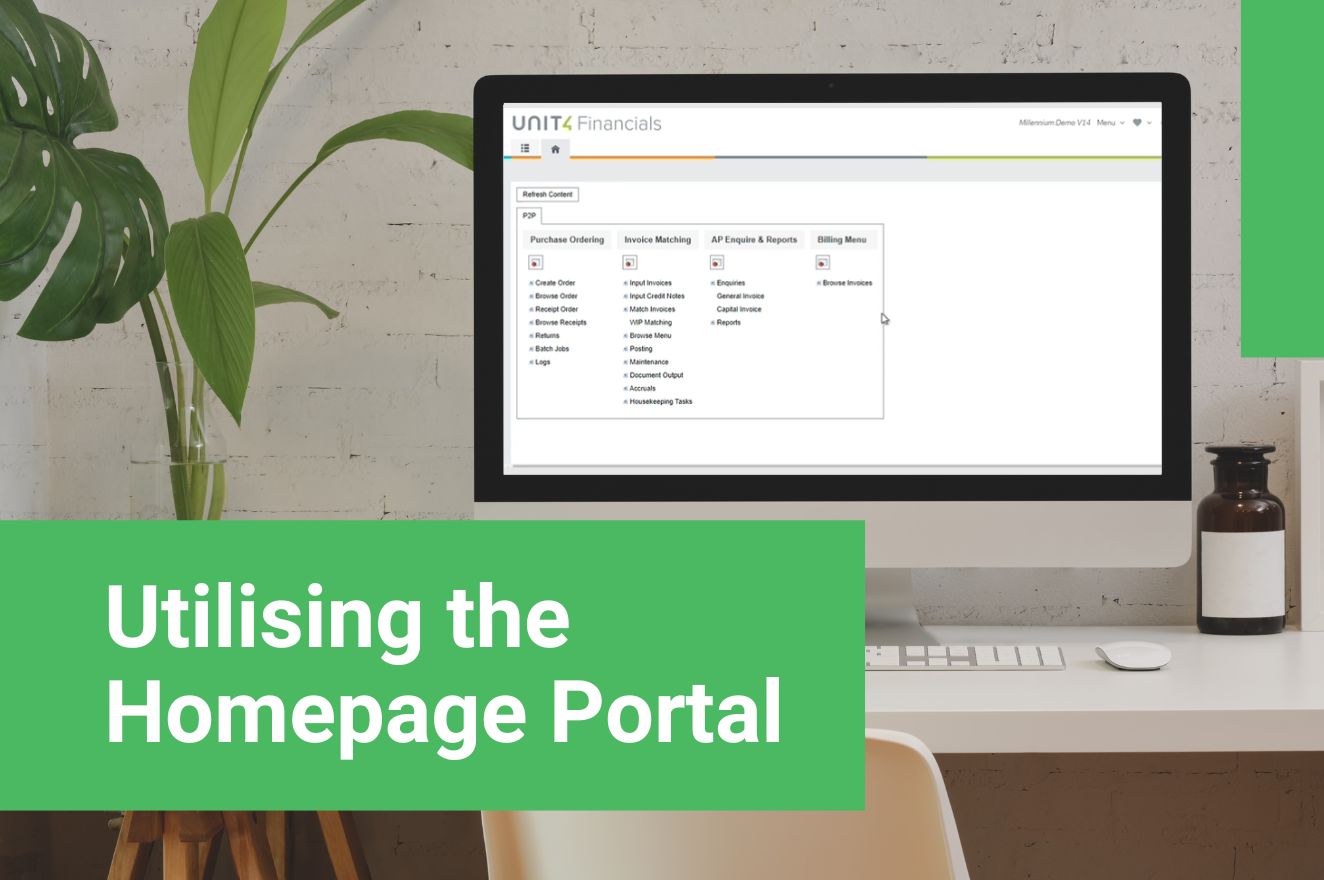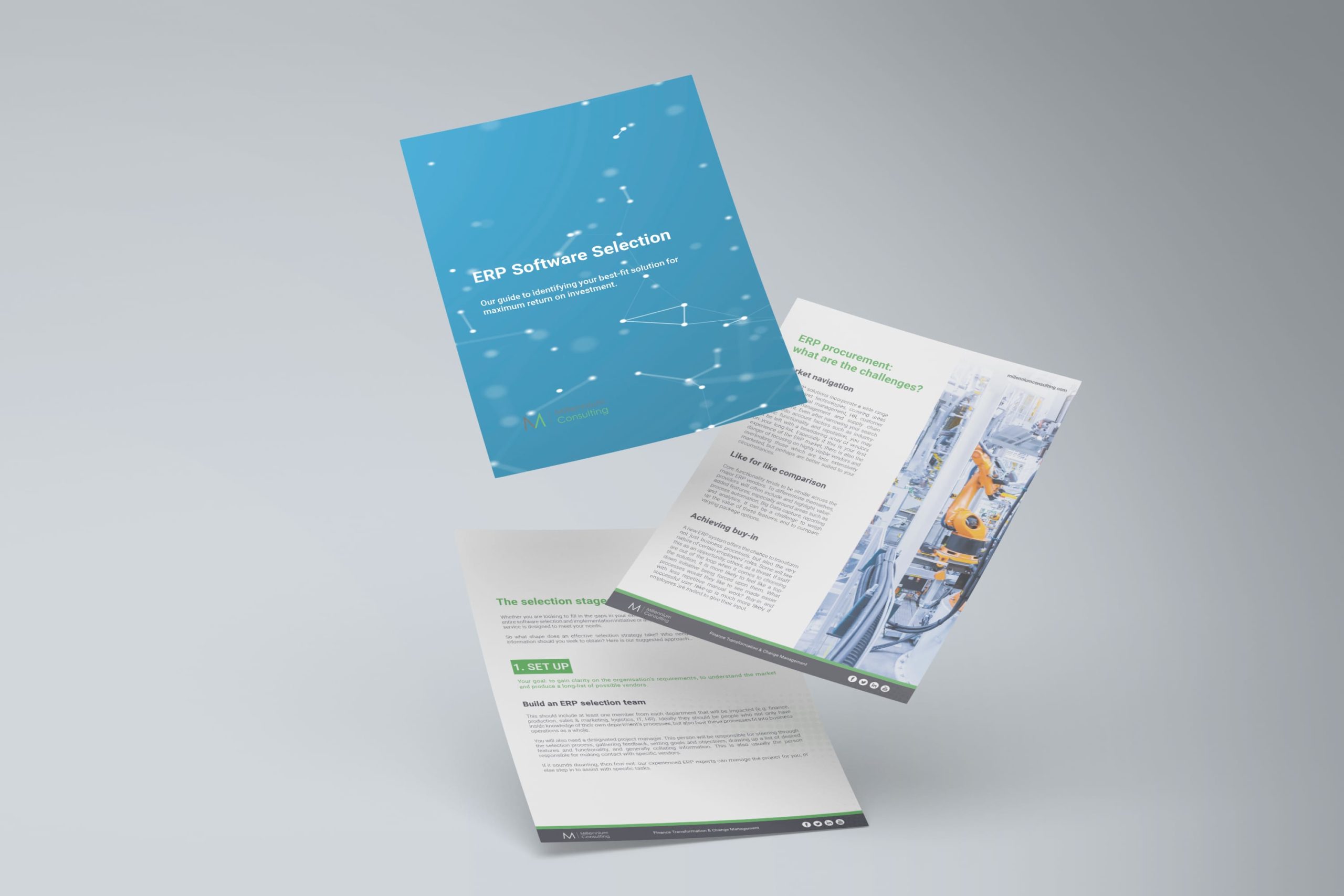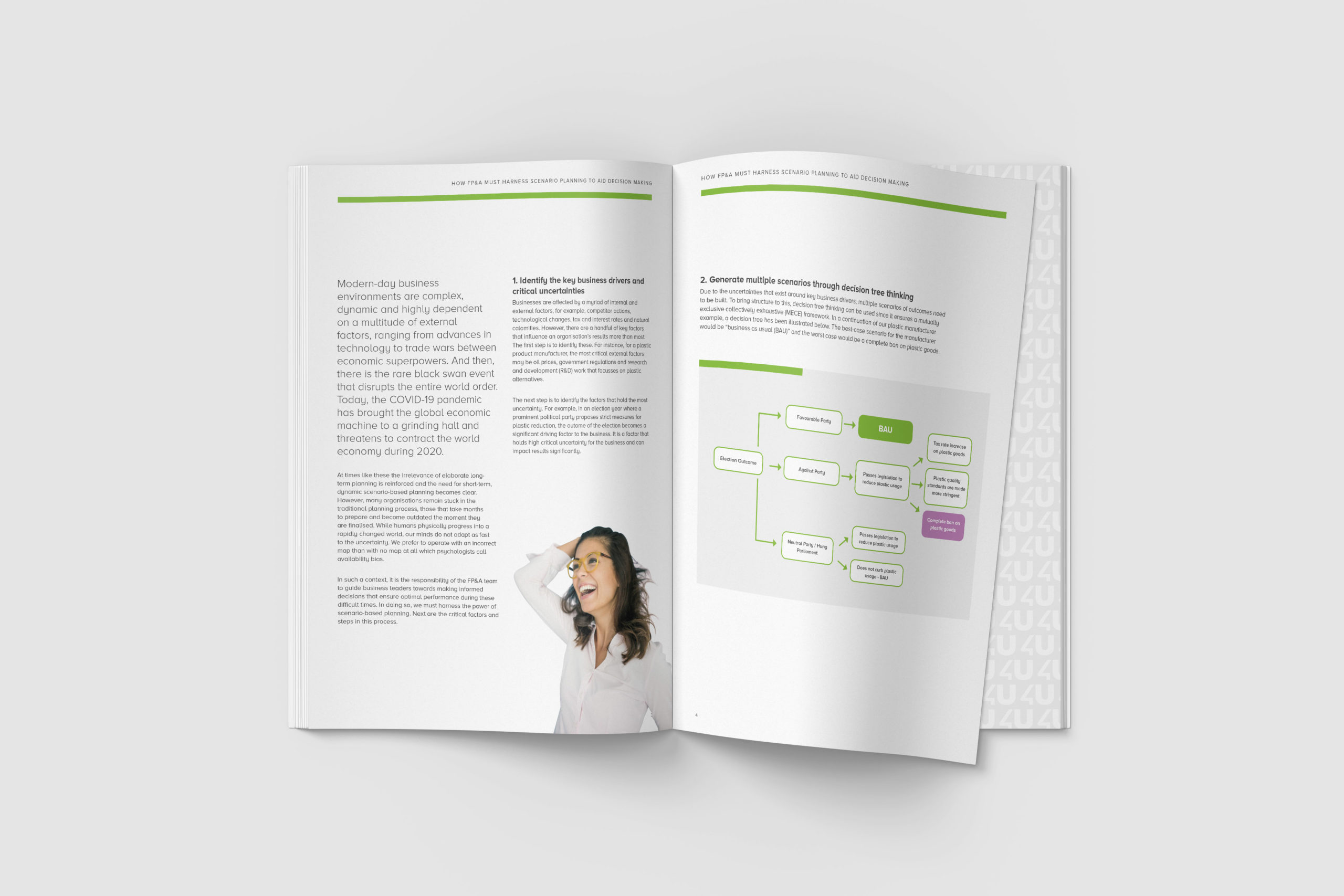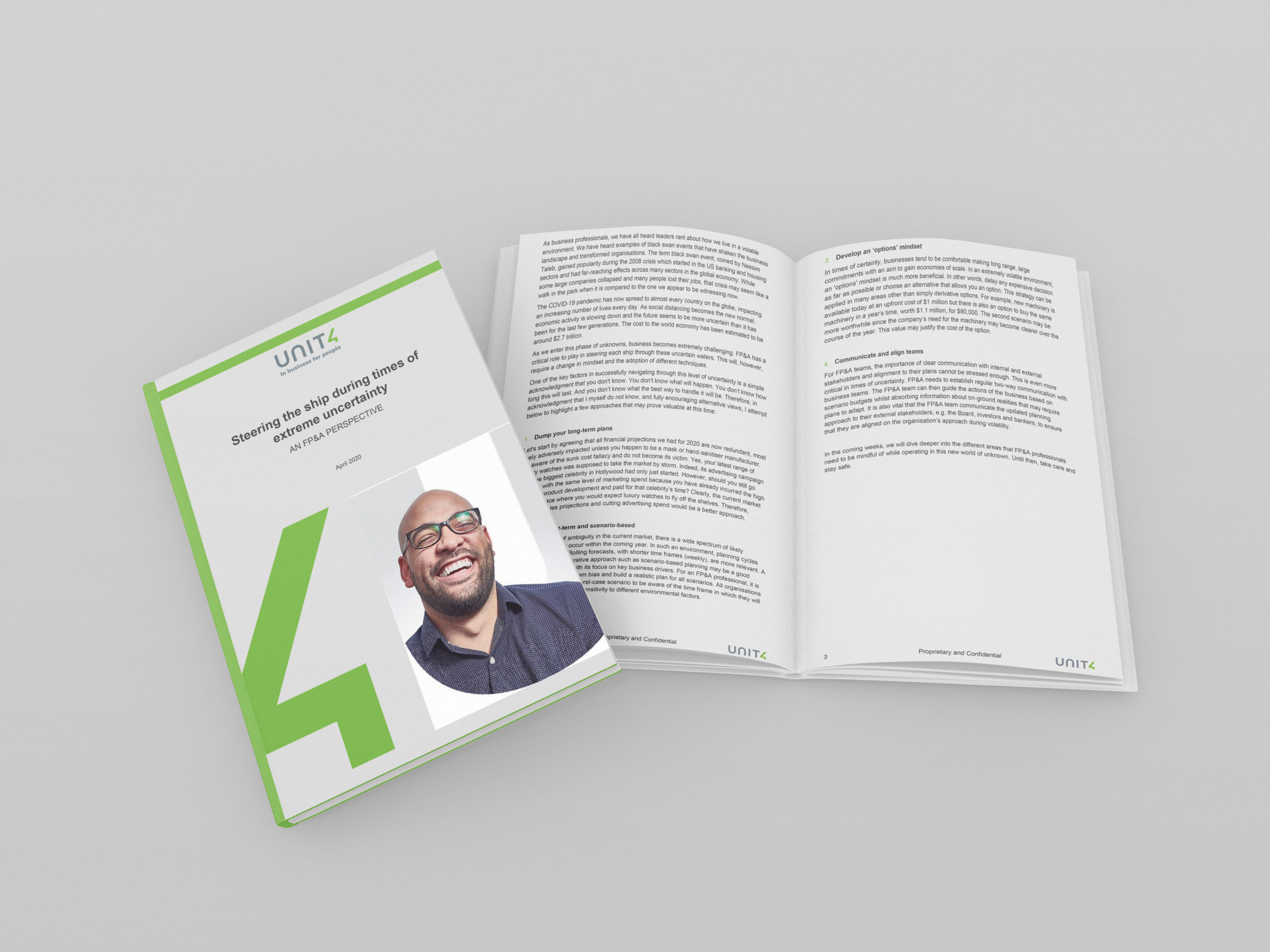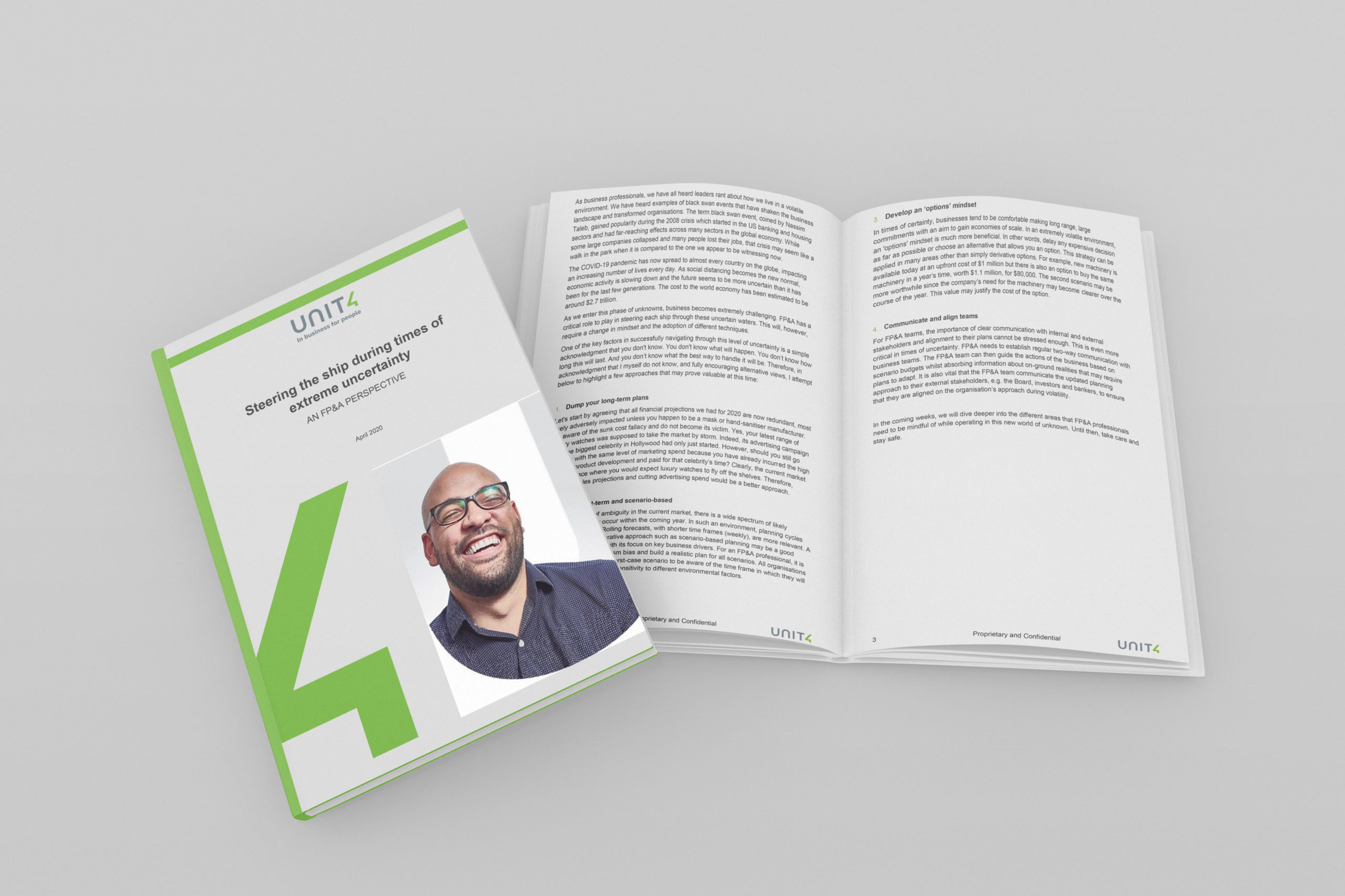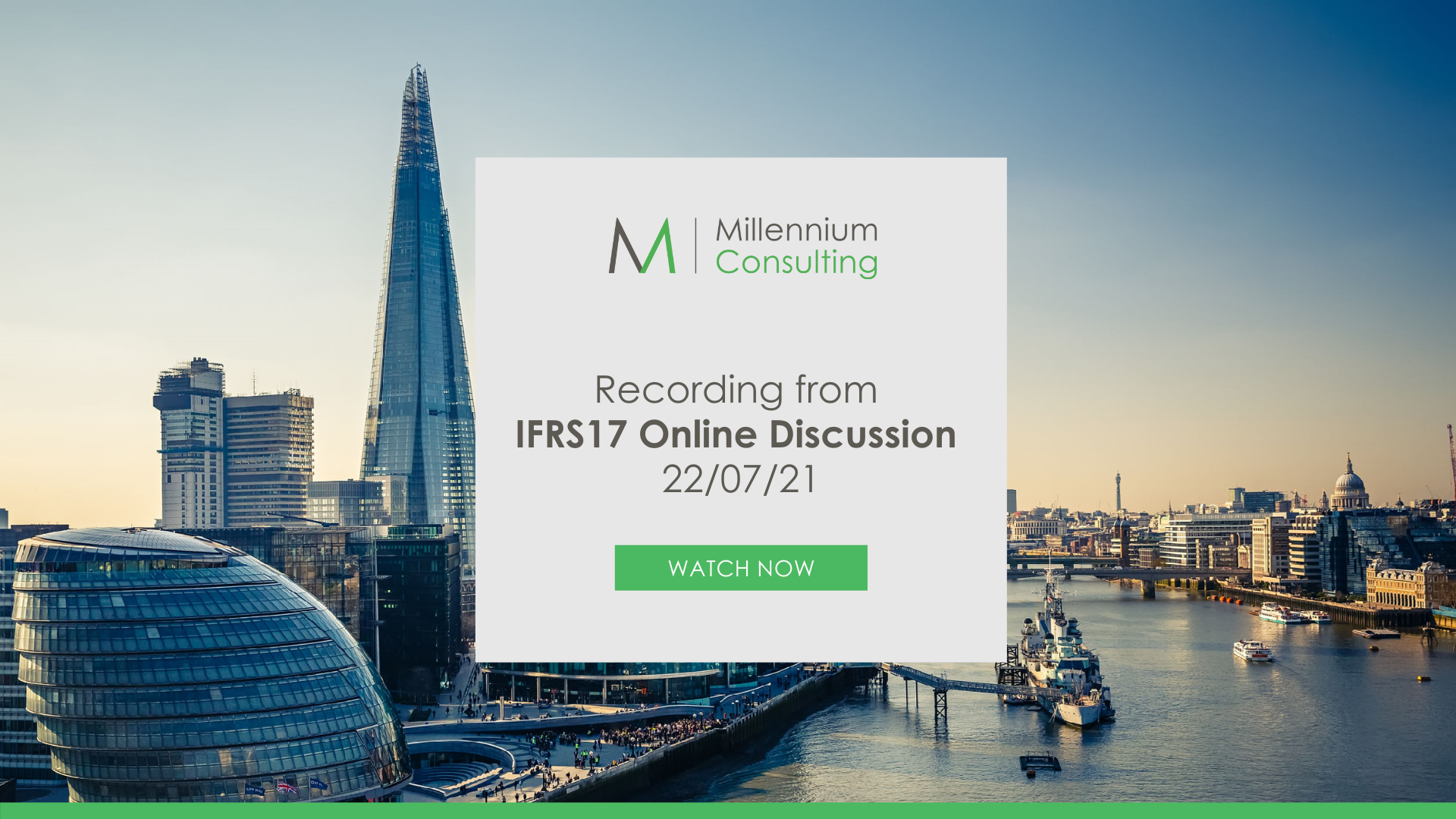What’s new in Unit4 Financials Continuous Release?
December 2021
What’s new in Unit4 Financials Continuous Release?
New functions rolled out under recent Unit4 Financials quarterly releases have significantly enhanced the user experience, further enabling your finance team to streamline business processes, reduce operational risk and free up resources for value-added work.
Here’s a summary of what has been added since October 2020, along with a closer look at some of the most noteworthy enhancements…
At a glance: release date summary
| CR 2021 Q4 (7th December 2021) |
| CR 2021 Q3 (14th September 2021) |
| CR 2021 Q2 (9th June 2021) |
| CR 2021 Q1 (9th March 2021) |
| CR 2020 Q4 (8th December 2020) |
| CR 2020 Q3 (14th October 2020) |
| V14 R16 (27th July 2021) |
| V14 R17 (end November 2021) |
- Hotfix to protect Unit4 Financials in the Log4j Java library
- Table Link Transfer Client
- Billing: Use Structured Output on Final Issue
- Billing: Copy Attachments on Posting
- Invoice matching: Set number of background matching threads
- Structured Output – UBL 2.1 Transformation: XML can be validated against the UBL 2.1 Invoice schema
- Attachments can now be managed from within the Billing Browse screen
- It is now possible to attach the PDF Invoice or Credit Note to the Billing document on final issue
- Scheduling a task of type Print Invoices now permits you to generate structured output for invoices (for example, XML in UBL 2.1 Transformation)
- Purchase orders approval can now be viewed across company in read-only mode
When you save masters, trailing spaces are now automatically removed. Print invoicing functionality is also improved, including support for XML formatting, as well as for invoices in pdf format.
- Documents outputs can now be written to an SFTP location
- Leading and trailing spaces are automatically removed when updating master names and short names
- The ‘Print Invoices’ function now allows an XML invoice. Transformation to be generated and sent. A pdf from a print format can be attached to the Finance document as its primary attachment
- The ‘Remove’ checkbox for additional lines in input is now positioned on the right-hand side by default
- Structured Output – UBL 2.1 Transformation: the generated XML file is now validated against the UBL Invoice schema
- Structured Output – UBL 2.1 Transformation: new vocabulary available including IBAN, attachment ID
This release included a number of enhancements that actually go a long way in improving the user experience. Examples include the new option to sort a paylist in descending order. There is also a new ‘element authorisation status’ for the financials selector master, which means that an element that isn’t authorised for changes can be excluded automatically without having to send a reminder or statement.
- Download XL for Unit4 Financials
- Document master setting to prevent the user who originally posted a document to the intray from posting the document to the books
- Pay/Collect summary now displays the pay proposal list by Pay Date in descending order
- Element authorisation status added to financials selector master
- New Punchout parameter added, user email
- Review Punchout items screen has new ‘select all’ and ‘deselect all’ buttons
- Punchout website now appears in a new tab in the browser
- Structured Output has a new transformation available, called ‘FEC’ Transformation (Fichier des ecritures compatables)
- Structured Output now allows zip file compression
- Structured Output can now generate .csv files without quotes
The new Tablelink for Cloud feature helps to simplify cloud migrations, removing the need to rewrite interfaces using web services and APIs. The release also included SFTP support, along with the ability to create comma-separated files that can be transported. e-Invoicing capabilities were also enhanced.
- Structured Output – CSV Transformation
- Structured Output – Output to SFTP
- Structured Output – Output to HTTP POST
- Tablelink for Cloud – Helper and API
- Improvements to upgrade Scripts
- e-Invoicing enhancements (Dutch XML invoice load)
- Unit4 Financials Idealization Process
Version 14 of Unit4 Financials saw the introduction of a new billing module. Among other enhancements, the 2020 Q3 continuous release saw an extension of these billing features.
- System users with OpenID Connect
- Billing – Quantities copied to Finance
- Billing – Print Preview
- Structured Output – Message Hub Output
- Unit4 Extension Kit – Samples
- Structured Output – GDPdU (local German product)
Having introduced a wide range of new features in the previous quarter, the 2020 Q2 release was focused mostly on routine product maintenance. However, there were a couple of new functions added. These were a scheduled task for reconciliation, along with changes to the Avalara export to accommodate HMRC’s ‘Making Tax Digital’ initiative.
- Scheduled task for Reconciliation
- Structured output changes – Avalara XMI export
This was the first release under Unit4’s new quarterly roll-out model (‘Continuous Release’). It introduced a wide range of new features.
- Schedule Task for hierarchy updates. You can now schedule new tasks for hierarchy updates and asset depreciation
- Submit orders on auto convert from requisitions
- Browse Transactions: Raise Corrective Journal
- Browse Transactions: Copy Document
- Deep link ‘balance’ drill to browse transactions
- Schedule Asset Depreciation
- Element template customisations copied via copy company. Element template customisations are now copied via the ‘copy company’ functionality
- Billing Copy Document
- Reconciliation Date & User. The introduction of this feature allows users to do retrospective reconciliation reports. In addition, the same level of functionality available in ‘browse details’ has also been extended to ‘browse transactions’
- Browse Transactions: Drill to Account Summary
- Browse Transactions: Edit Comment via related information panel
- Browse Transactions: Workflow Actions
- Provisional and Undo Year-End. Learn more about these features here
- Migrate customisations from test to live
- Allow change to balances on company master
- LRN Housekeeping without posting
- Reference Attachment Hyperlink as Direct Link
- GDPR for Element history
- Make use of address categories in Procurement Ordering
- Add Element Flexi-Fields data to Copy Company
- Change Pay Period. This is the ability to be able to change the period during a pay proposal
- Interco control to contain customer/supplier elements
Should you upgrade your Unit4 Financials software in 2022?
Support for Unit4 Financials V13 has already been withdrawn. Support for V14 will expire at the end of 2022. Failure to upgrade before then increases the likelihood of incurring extended support charges from Unit4.
Upgrading enables you to:
- Access the latest functionality
- Reduce operational risk and processing costs
- Continue to access Unit4’s “in support” software maintenance and support package
- Ensure you are up to date with Unit4’s latest software security package
As an Elite Unit4 Partner, Millennium Consulting specialises in delivering a seamless upgrade, while also ensuring your upgraded solution is fully aligned with organisational requirements.
Unit4 Financials Continuous Release: Provisional Year End and Year End Undo
November 2021
Unit4 Financials Continuous Release: Provisional Year End and Year End Undo
Here’s a closer look at the latest version’s new Provisional Year End and Year End Undo functions, and the benefits these will bring to your reporting procedures.
So, what has changed?
- A new Provisional Year End function. This performs all the processing of a full year end, but without closing the year in question, so you can continue posting to that year.
- A Year End Undo function. You can now undo a year end after it has been closed. Having effectively unlocked it, you are then free to post to the year in question.
Provisional Year End function
This new provisional mode option gives organisations more control over year-end. No longer do you have to wait for the auditors to give the green light before running a ‘once-and-for-all’ process. Instead, you can create and update a provisional version at any time within the system, and subsequently close it when you are ready.
If a requirement for further adjustment is flagged up after close, the undo function makes it easy to rectify it.
The new functionality is only available to users who have upgraded to Unit4 Financials 2020 / Continuously Release (previously known as Version 15). Under this latest software version, users have a choice of two modes for running a year end: provisional or full.
Undo Year End function
The new undo year end feature in Unit4 Financials Continuous Release is a further useful addition to the system’s functionality. It means you can now undo both provisional and full year ends.
When activated, the undo function cancels all year end journals posted to the final period for the latest year in which a year end has been run, as well as to the opening period of the following year. If a full year end is undone, then the minimum year will be reset to the previous year.
Benefits for finance teams
The new provisional mode gives finance officers a much greater degree of flexibility in the timing of their year end process.
Previously, launching the year end process always meant closing the year, which in turn generally meant the process could not be triggered unless and until the auditors had completed their final checks. Now, you have the option of running a report at any time of your choosing. As well as being a useful internal resource for finance, there may also be wider situations where the ability to rapidly generate a provisional year end will be useful, such as updating the executive team or providing information to external stakeholders.
Furthermore, year end close traditionally meant that the accounts for the year in question were locked down for further adjustments. The undo year end function provides a useful failsafe measure: if a discrepancy is discovered further down the line, you have the option of rectifying it quickly and easily.
Watch these new functions in action
A painless Unit4 Financials upgrade starts here
Are you currently running Unit4 Coda Financials V13 or earlier? With support for these legacy versions now withdrawn, this is the time to upgrade.
Millennium Consulting specialises not only in ensuring the upgrade process is a seamless one, but also in ensuring your upgraded solution is fully aligned with what your organisation wants to achieve. To explore your upgrade options, contact us today.
Is it time to upgrade?
Upgrading your finance software can provide new functionality, increased automation and more efficient processes.
Utilising the Homepage Portal in Unit4 Financials
November 2021
In this blog post discover how the Unit4 Financials Homepage Portal can transform the user experience, enabling easier navigation, faster processing, and more effective day-to-day task management.
The Homepage Portal is available on Unit4 Financials V12 onwards.
If you are a user who has been allocated a Homepage Portal, your default screen when logging onto the system will look something like this:
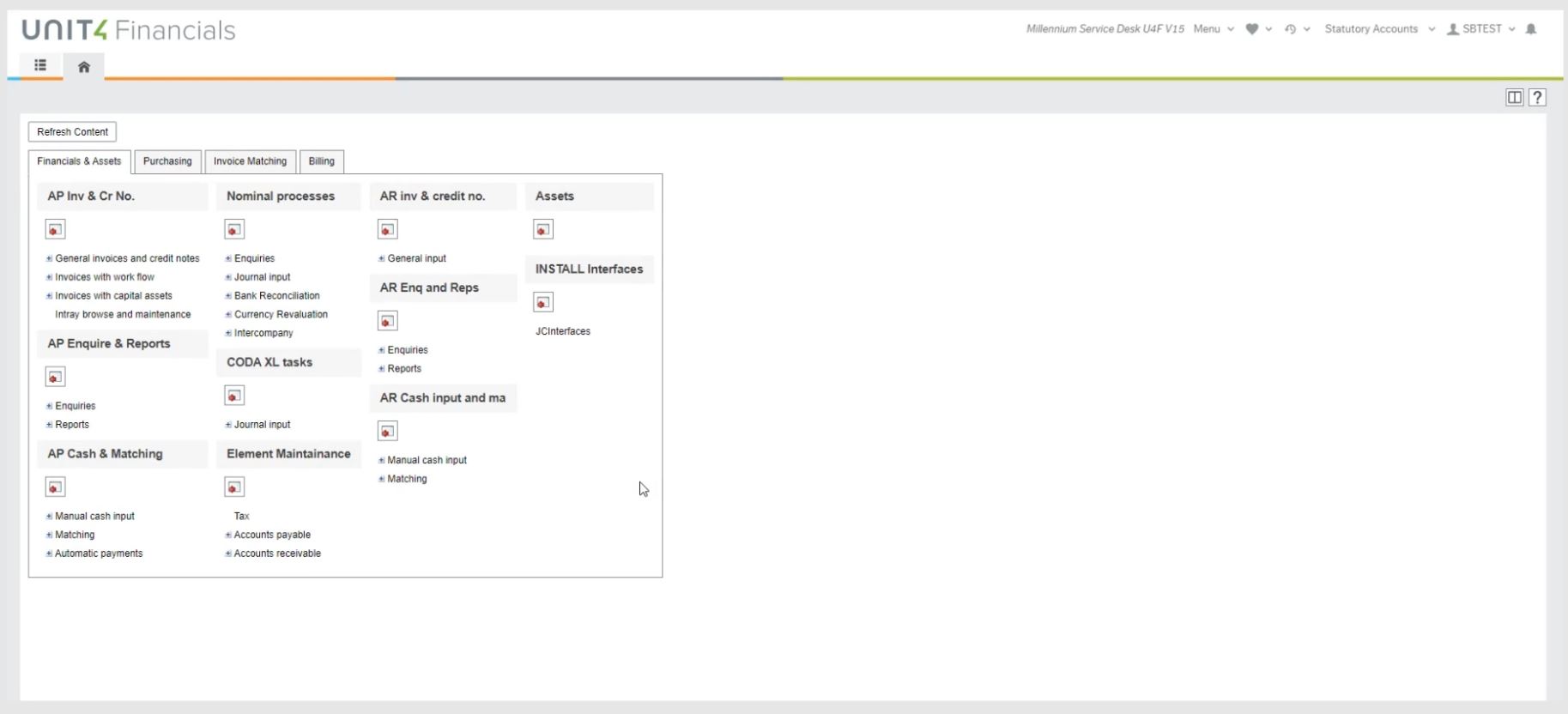
It’s refreshingly simple, comprising of three elements:
Tabs. The tabs are pages relating to distinct operational areas; in this case, Finance & Assets, Purchasing, Invoice Matching and Billing. The Portal is completely customisable, so you can match the tabs to the individual user’s role and responsibilities. For example, in the case of a team member whose sole responsibility is administering incoming invoices, the portal might include just a single tab: Accounts Payable.
Frames. The frames are used to group together similar content providers (see below) by subject area.
Content providers. Clicking on a content provider will take you directly to a specific report or function. For instance, under the Nominal processes frame within the Finance & Assets tab, a user can instantly navigate to Enquiries, Journal Input, Bank Reconciliation, Currency Revaluation or Intercompany Adjustments, simply by clicking on the relevant content provider.
Watch how the Portal speeds up task performance
Watch a demonstration of a search carried out from the main menu, and the same search executed via the Portal model.
The Portal approach is significantly more effective at taking users exactly directly where they need to be. There’s far less manual entry and toggling through presenters and selectors. On an individual user level, it’s quicker and easier. And once you apply it to a large finance team, all of whom execute dozens of processes and queries a day, it can make a huge difference to organisational productivity.
Portal setup
Portals are set up at system administrator-level. Before you start to set up a Portal, we recommend that you have a sketch map of the way you want the menus to be displayed, and the content.
Unlocking Unit4 Financials expertise
If you would like expert input on Homepage configuration, we’re here to help.
Whether you are looking for ‘easy wins’ from your existing setup, best practice advice on the platform’s latest functionality or a complete re-implementation, Millennium Consulting can provide the support you need. To access unrivalled expertise from a Unit4 Elite Partner, speak to us today.
Is it time to upgrade?
Upgrading your finance software can provide new functionality, increased automation and more efficient processes.
A Better Way to Work
A Better Way to Work
October 2021
In this white paper, you can learn.
- To make your people key to reconfiguring processes, regardless of IT expertise
- Real-time visibility can power better decision-making
- Automating tasks will improve efficiency
- To make your organisation more agile and adaptive
Read the white paper today to find a better way to work.
ERP Software Selection
ERP Software Selection
The promise of ERP (Enterprise Resource Planning) is a compelling one. Deploy the right solution and it can help deliver a complete view of your business, integrate processes and data, drive efficiency, boost productivity and sharpen your competitive edge.
But as with any major software implementation project, success is not guaranteed. Even a seasoned procurement manager can be captivated by the bells and whistles such as swish visualisations and impressive-sounding AI capabilities, while potentially losing sight of the nuts and bolts: i.e. the ability of the system to meet your real-life business problems.
Read our guide to identifying your best-fit solution for maximum return on investment.
We’re now registered providers with the CPD Certification Service
We’re now registered providers with the CPD Certification Service
August 5th, 2021
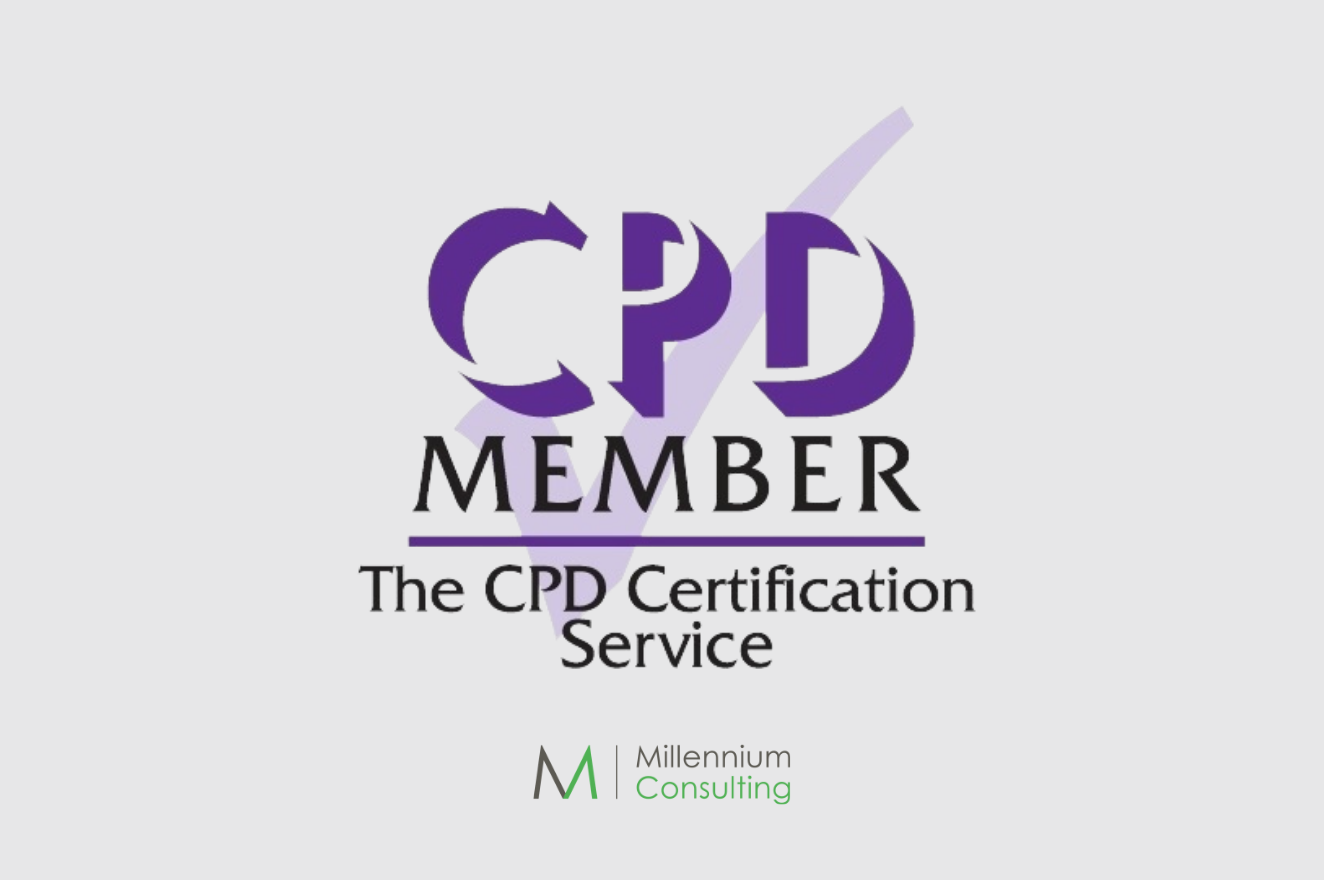
Millennium Consulting is pleased to announce that they are now an official registered provider with the CPD Certification Service. Established in 1996, The CPD Certification Service is the largest and leading independent CPD accreditation organisation working across all industry sectors.
This means finance professionals undertaking courses run by Millennium Consulting count towards annual professional development requirements set by professional regulators. Any delegate attending the future courses will be issued with an accredited CPD Certificate of Attendance, which they can subsequently use within their formal CPD record for a professional body, institute or employer.
Millennium is currently submitting courses for approval, and these will soon be available to book via the CPD Service.
Jeremy Lucas at Millennium Consulting said, “I am pleased to announce that Millennium Consulting is working towards being able to offer CPD certified courses to finance professionals. This is not only further confirmation of the high quality of our services but also endorses our view of the importance of good assessment practice. Our CPD programme will allows you to keep up to date with the latest industry trends and best practice, learn new skills and develop existing ones.”
Our accreditation can be verified by clicking this link: https://cpduk.co.uk/providers/millennium-consulting
How Financial Planning & Analysis Must Harness Scenario Planning to Aid Decision Making
How Financial Planning & Analysis Must Harness Scenario Planning to Aid Decision Making
July 2021
This whitepaper discusses how FP&A teams can harness the power of scenario-based planning to guide business leaders towards making informed decisions that ensure optimal performance during difficult times.
It is the responsibility of the FP&A team to guide business leaders towards making informed decisions that ensure optimal performance during difficult times. In doing so, they must harness the power of scenario-based planning. Below are the critical factors and steps in this process that we will discuss:
- Identifying the key business drivers and critical uncertainties.
- Generating multiple scenarios through decision tree thinking.
- Being mindful of possible cognitive errors and be receptive to the external environment.
- Harnessing the technological tools available to enable real-time planning solutions.
Steering the ship during times of extreme uncertainty
Steering the ship during times of extreme uncertainty
July 2021
Our “Steering the Ship During Times of Extreme Uncertainty” paper looks at how critical FP&A is as we enter the phase of the unknown during & after COVID-19. It highlights important approaches that may prove valuable to those in FP&A across all verticals.
One of the key factors in successfully navigating through levels of uncertainty is a simple acknowledgment that you don’t know. You don’t know what will happen. You don’t know how long this will last. And you don’t know what the best way to handle it will be.
Therefore, in acknowledgment that we do not know, and fully encouraging alternative views, we attempt to highlight a few approaches that may prove valuable to you. We discuss:
- Dumping your long-term plans.
- Thinking short-term and scenario-based.
- Developing an ‘options’ mindset.
- Communicating and aligning teams.
Recording from IFRS17 Online Discussion 22/07/21
2021 is a critical year for insurers working on IFRS17 compliance programs involving new actuarial models and technology platforms. Successful systems implementation is crucial and UAT, systems integration testing and dry runs are the current primary focus. Many challenges remain and the ability to work collaboratively across business disciplines (Finance, IT, Actuarial etc.) is essential.
We have delivered more than 1,000 projects, leveraging teams of experts across business transformation, technology and stakeholder management. Change is a journey, and we have the knowledge and experience to support you at every stage.
Millennium Raising Futures Kenya Golf Day 2021

Millennium Raising Futures Kenya Golf Day
July 5th, 2021
It’s fair to say that the summer of 2021 has been unpredictable weatherwise, so when the annual Millennium Consulting Raising Futures Kenya Golf Day took place last Friday it was hard to know what to expect.
Faversham Golf Club in Kent played host and the event continued the tradition of supporting Raising Futures Kenya (formerly Vision Africa) over the past 16 years.
Heartfelt thanks are due to the loyal support of our many corporate sponsors, the players who took part and the event organisers without whose organisational skills the day would not have run so well.
The weather turned out ideal and with the golf course in good condition, an enjoyable day was had by all. The format was a Ryder Cup style competition with European v USA teams vying once more for the Millennium trophy. With evenly matched teams, this year it was the turn of Europe, captained by Craig Bassingthwaighte and vice-captain Malcolm Coton to emerge as victors.
The 4-ball team prize was won by Ben Hunt, Harry Wallis, Mark Cranefield and Shoaib Laher. Harry Wallis also won the individual stableford prize and the ladies winner was Gwen Finch. The individual scratch score winner was Adam Bassingthwaighte who went round in a creditable 76. Closest to the flag was Roger Lightfoot whilst Harry Wallis extended his winning run by achieving the longest drive.
Covid-19 restrictions meant that the traditional pre and post round presentations/awards could not take place in the normal manner however Andy King of Raising Futures Kenya had recorded a video which brought us up to date with what has been happening in Kenya during this difficult Covid period. It is worth taking a few minutes to watch it as it highlights the value of the financial contribution we make each year from our golf day.
£3,000 was raised and we look forward to hearing from Raising Futures Kenya how the funds are used when we get together next year.
If you are interested in taking part in 2022 then please refer to www.millenniumconsulting.com for details and registration when available.



